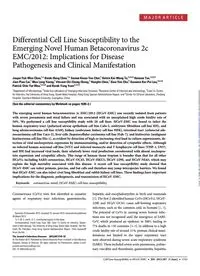
2013 Differential Cell Line Susceptibility to the Emerging Novel Human Betacoronavirus 2c EMC_2012_ Implications for Dis PDF
Preview 2013 Differential Cell Line Susceptibility to the Emerging Novel Human Betacoronavirus 2c EMC_2012_ Implications for Dis
M A J O R A R T I C L E Differential Cell Line Susceptibility to the Emerging Novel Human Betacoronavirus 2c EMC/2012: Implications for Disease Pathogenesis and Clinical Manifestation Jasper Fuk-Woo Chan,1,a Kwok-Hung Chan,1,a Garnet Kwan-Yue Choi,1 Kelvin Kai-Wang To,1,2,3,4 Herman Tse,1,2,3,4 Jian-Piao Cai,1 Man Lung Yeung,1 Vincent Chi-Chung Cheng,1 Honglin Chen,1 Xiao-Yan Che,5 Susanna Kar-Pui Lau,1,2,3,4 Patrick Chiu-Yat Woo,1,2,3,4 and Kwok-Yung Yuen1,2,3,4 1Department of Microbiology, 2State Key Laboratory of Emerging Infectious Diseases, 3Research Centre of Infection and Immunology, 4Carol Yu Centre for Infection, the University of Hong Kong, Queen Mary Hospital, Hong Kong Special Administrative Region, and 5Center for Clinical Laboratory, Zhujiang Hospital, Southern Medical University, Guangzhou, China (See the editorial commentary by McIntosh on pages 1630–2.) The emerging novel human betacoronavirus 2c EMC/2012 (HCoV-EMC) was recently isolated from patients with severe pneumonia and renal failure and was associated with an unexplained high crude fatality rate of 56%. We performed a cell line susceptibility study with 28 cell lines. HCoV-EMC was found to infect the human respiratory tract (polarized airway epithelium cell line Calu-3, embryonic fibroblast cell line HFL, and lung adenocarcinoma cell line A549), kidney (embryonic kidney cell line HEK), intestinal tract (colorectal ade- nocarcinoma cell line Caco-2), liver cells (hepatocellular carcinoma cell line Huh-7), and histiocytes (malignant histiocytoma cell line His-1), as evident by detection of high or increasing viral load in culture supernatants, de- tection of viral nucleoprotein expression by immunostaining, and/or detection of cytopathic effects. Although an infected human neuronal cell line (NT2) and infected monocyte and T lymphocyte cell lines (THP-1, U937, and H9) had increased viral loads, their relatively lower viral production corroborated with absent nucleopro- tein expression and cytopathic effects. This range of human tissue tropism is broader than that for all other HCoVs, including SARS coronavirus, HCoV-OC43, HCoV-HKU1, HCoV-229E, and HCoV-NL63, which may explain the high mortality associated with this disease. A recent cell line susceptibility study showed that HCoV-EMC can infect primate, porcine, and bat cells and therefore may jump interspecies barriers. We found that HCoV-EMC can also infect civet lung fibroblast and rabbit kidney cell lines. These findings have important implications for the diagnosis, pathogenesis, and transmission of HCoV-EMC. Keywords. coronavirus; novel; HCoV-EMC; cell line; susceptibility. Coronaviruses (CoVs) were first identified as causative agents of respiratory tract infections, gastroenteritis, hepatitis, and encephalomyelitis in birds and mammals [1]. The first 2 identified human CoVs (HCoVs), HCoV- 229E and HCoV-OC43, cause self-limiting respiratory infections, such as the common cold, in humans [2, 3]. The potential of CoVs in causing severe human infec- tions was not recognized until the emergence of SARS- CoV, which produced an epidemic in 2003, leading to 774 deaths in >30 countries [4–9]. In addition to a high crude fatality rate of around 11%, protean clinical mani- festations not limited to the upper respiratory tract were observed during severe acute respiratory syndrome (SARS). These included severe acute pneumonia, pulmo- nary vasculitis and thrombosis, gastroenteritis, hepatitis, Received 23 December 2012; accepted 10 January 2013; electronically published 26 March 2013. aJ. F.-W. C. and K.-H. C. contributed equally to the study. Correspondence: Kwok-Yung Yuen, MD, Carol Yu Centre for Infection, Depart- ment of Microbiology, The University of Hong Kong, Queen Mary Hospital, 102 Pok- fulam Rd, Pokfulam, Hong Kong Special Administrative Region, China (
